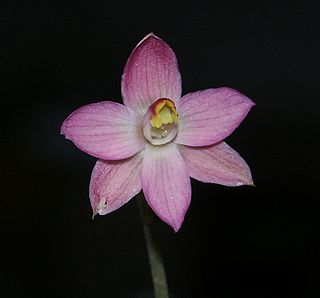
Thelymitra rubra, commonly called the salmon sun orchid or pink sun orchid, is a species of orchid endemic to southeastern Australia. It has a single thin, grass-like leaf and up to five salmon pink flowers with broad, toothed arms on the sides of the column. It is similar to T. carnea but the flowers are larger and the column arms are a different shape.

Thelymitra ixioides, known as the spotted sun orchid or dotted sun orchid, is a species of orchid that is native to southern and eastern Australia and to New Zealand. It has a single long, thin, dark green leaf and up to ten flowers which occur in a range of colours, most commonly blue to purple but usually with small, dark blue spots. It is a variable species, similar to T. juncifolia which has smaller flowers.
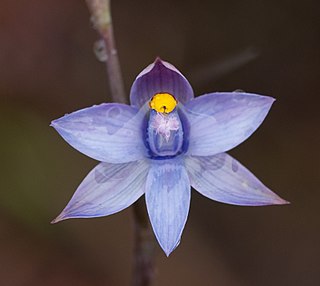
Thelymitra malvina, commonly called the mauve-tufted sun orchid, is a species of orchid that is native to eastern Australia and New Zealand. It has a single large, fleshy leaf and up to twenty five blue to mauve flowers with pink or mauve tufts on top of the anther.
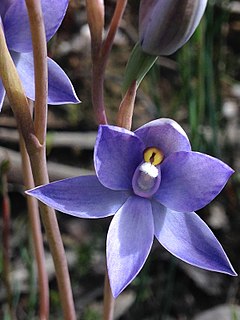
Thelymitra megacalyptra, commonly called the plains sun orchid, is a species of orchid that is endemic to eastern Australia. It has a single erect, fleshy leaf and up to fifteen blue to purplish, sometimes lilac, pink or white flowers with white tufts on top of the anther. It is known as Thelymitra megcalyptra by some authorities.
Thelymitra exigua, commonly called the short sun orchid, is a species of orchid that is endemic to south-eastern Australia. It has a single fleshy, channelled, dark green leaf and up to eight relatively small pale blue flowers with white toothbrush-like tufts on top of the anther.

Thelymitra holmesii, commonly called the blue star sun orchid, is a species of orchid that is endemic to south-eastern Australia. It has a single long, narrow, fleshy leaf and up to nine purplish blue to mauve flowers with a deeply notched lobe on top of the anther.

Thelymitra epipactoides, commonly called the metallic sun orchid, is a species of orchid that is endemic to south-eastern continental Australia. It has a single relatively large, leathery leaf and up to twenty large flowers that range in colour from pink to reddish but have a distinctive arrangement of lobes above the anther.
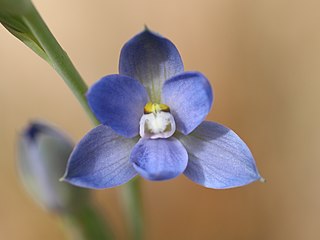
Thelymitra improcera, commonly called the coastal sun orchid, is a species of orchid that is endemic to south-eastern Australia. It has a single erect, fleshy leaf and up to eight relatively small pale to bright blue flowers on a short flowering stem. The lobe on top of the anther is unusually short and lobed.
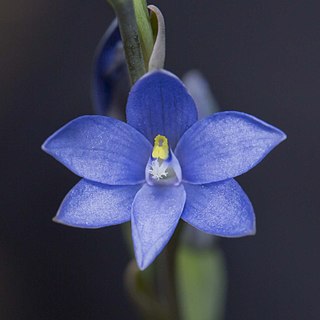
Thelymitra longiloba, commonly called the lobed sun orchid, is a species of orchid that is endemic to south-eastern Australia. It has a single erect, fleshy, channelled leaf and up to six relatively small blue flowers with side lobes above the anther. Although widespread, it only occurs in disjunct populations and is classed as "endangered".
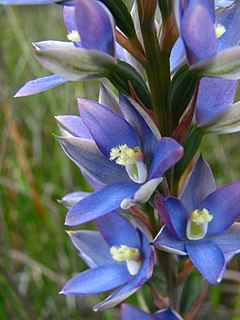
Thelymitra circumsepta, commonly called the naked sun orchid, is a species of orchid that is endemic to south-eastern Australia. It has a single leathery, dark green leaf and up to twenty blue to purplish or pink flowers with fringed lobes and yellowish hair tufts on top of the column.

Thelymitra luteocilium, commonly called the fringed sun orchid, is a species of orchid that is endemic to south-eastern Australia. It has a single fleshy, dark green leaf and up to six pale pink to reddish flowers with a short wavy lobe on top of the column.
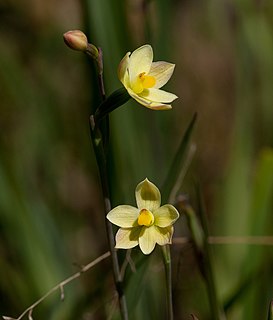
Thelymitra flexuosa, known as the twisted sun orchid, is a species of orchid that is endemic to southern Australia. It has a single thin, wiry leaf and up to four cream-coloured to canary yellow flowers with four rows of short hairs on the back of the column. It is a common and widespread species, superficially similar to T. antennifera.
Thelymitra colensoi, commonly called Colenso's sun orchid, is a species of orchid in the family Orchidaceae that is endemic to New Zealand. It has a single fleshy, channelled leaf and up to seven pale blue or mauve to pink flowers. It is similar to T. pauciflora but is smaller and less robust than that species.
Thelymitra × chasmogama, commonly called the globe-hood sun orchid, is a species of orchid that is endemic to south-eastern Australia. It has a single tapering, channelled leaf with a reddish base and up to six bright pink flowers with pale yellow tufts on top of the anther. It is a natural hybrid between T. luteocilium and T. megacalyptra.
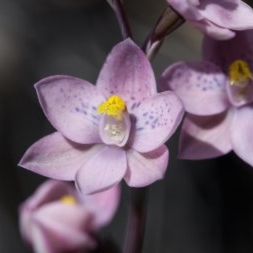
Thelymitra irregularis, usually known as Thelymitra × irregularis by Australian authorities, and commonly called the crested sun orchid, is a species of orchid that is endemic to south-eastern Australia. It has a single tapering, dark green leaf and up to eight bright rose pink flowers with darker spots and an irregular yellow crest on top of the anther. It is a natural hybrid between T. ixioides and either T. carnea or T. rubra.

Thelymitra × macmillanii, commonly called the red sun orchid or crimson sun orchid is a species of orchid that is endemic to south-eastern Australia. It has a single tapering, channelled leaf and up to five bright red, sometimes yellow flowers. It is a natural hybrid between T. antennifera and T. carnea or T. rubra.
Thelymitra × truncata, commonly called the truncate sun orchid, is a species of orchid that is endemic to south-eastern Australia. It has a single tapering, more or less flat leaf with a reddish base and up to six blue, pink or white flowers with a tube-shaped lobe on top of the anther. It is a natural hybrid between a range of species, including T. pauciflora and T. ixioides.

Thelymitra × dentata, commonly called hybrid sun orchid, is a species of orchid in the family Orchidaceae that is endemic to New Zealand. It has a single fleshy, channelled leaf and up to six blue or pink flowers with prominent dark blue stripes. It is a natural hybrid between T. longifolia and T. pulchella and is only found where the parent species occur together.
Thelymitra hatchii, commonly called Hatch's sun orchid, is a species of orchid in the family Orchidaceae that is endemic to New Zealand. It has a single erect, deeply channelled, dark reddish green leaf and up to eight mauve or pink flowers. The lobe on top of the anther is red with a yellow top and the arms on the sides of the column have tufts of pale yellow hairs.
Thelymitra nervosa, commonly called the spotted sun orchid, is a species of orchid in the family Orchidaceae that is endemic to New Zealand. It has a single broad, channelled leaf and up to ten blue flowers with darker spots.














